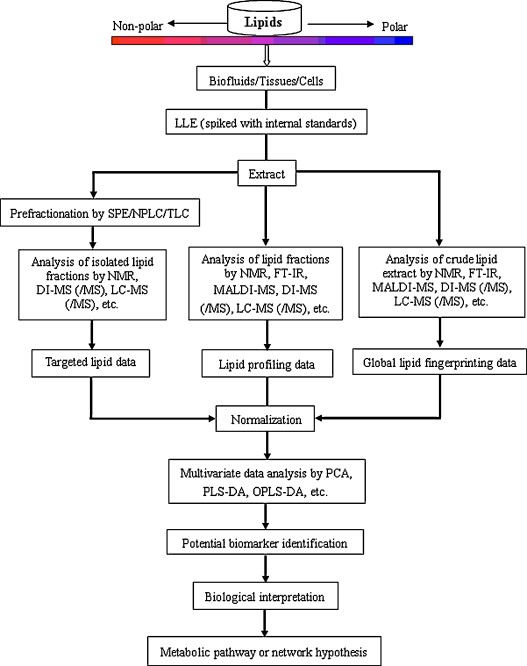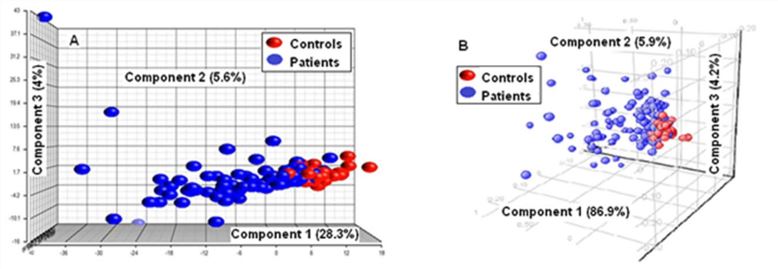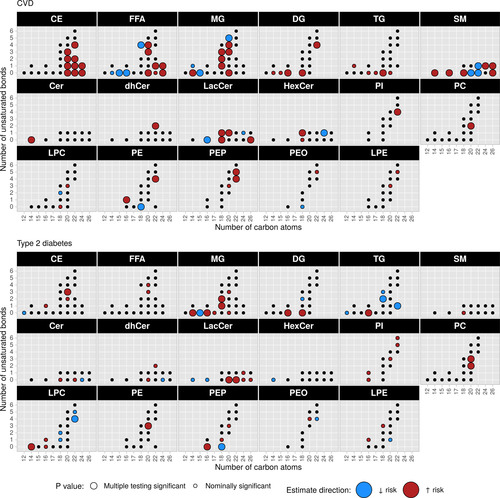Disease Lipid Biomarkers Assay
Lipids have a variety of biological functions in life processes, such as cell membrane formation, energy storage and cell signaling, and they can reflect most metabolic states in health and disease.
They can reflect most of the metabolic states in health and disease. Many studies have demonstrated that disorders or abnormalities in lipid metabolism can lead to a variety of human diseases, including diabetes, obesity, atherosclerosis, coronary heart disease, and brain damage.
Obesity, for example, is one of the most important risk factors for cardiovascular disease and diabetes mellitus. High lipid levels, especially substantially elevated low-density lipoprotein (LDL) and TG levels and reduced high-density lipoprotein (HDL) ChoE levels, are commonly found in abdominally obese individuals. Therefore, monitoring the effects of certain molecular classes of lipid metabolites in biological samples subjected to external stimuli or disturbances in disease processes will help to identify lipid metabolites indicative of metabolic disorders or diseases.
With the advancement of analytical techniques for lipid compounds, lipid compounds can be better and more comprehensively characterized, identified and quantified. Lipidomics-based analytical techniques reveal the correlation between abnormal lipid metabolism and disease, search for potential biomarkers, and identify new lipid molecule species.
Creative Proteomics provides lipidomic analysis services to characterize potential biomarkers of differences in disease and health status. Combined with a targeted lipidomics analysis platform, we reveal changes in the profile of lipid compounds in our targets to enable lipid metabolite discovery and identification.
 Fig1. Different approaches in lipid research for biomarker discovery (Hu, Chunxiu.; et al, 2009)
Fig1. Different approaches in lipid research for biomarker discovery (Hu, Chunxiu.; et al, 2009)
Case 1
Using lipidomics, lipid profiling of 390 individual apparent lipid species was performed on 141 plasma samples from 105 patients with prostate cancer and 36 male controls.
High throughput data generated from lipidomics were analyzed using bioinformatic and statistical methods. From 390 apparent lipid species, 35 species were demonstrated to have potential in differentiation of prostate cancer. Within the 35 species, 12 were identified as individual plasma lipid biomarkers for diagnosis of prostate cancer with a sensitivity above 80%, specificity above 50% and accuracy above 80%. Using top 15 of 35 potential biomarkers together increased predictive power dramatically in diagnosis of prostate cancer with a sensitivity of 93.6%, specificity of 90.1% and accuracy of 97.3%. Principal component analysis (PCA) and hierarchical clustering analysis (HCA) demonstrated that patient and control populations were visually separated by identified lipid biomarkers.
Three out of 13 lipid classes, phosphatidylethanolamine (PE), ether-linked phosphatidylethanolamine (ePE) and ether-linked phosphatidylcholine (ePC) could be considered as biomarkers in diagnosis of prostate cancer.
 Fig2. Comparison of PCA with 390 and 15 selected plasma apparent lipid species (Zhou, Xinchun.; et al, 2012)
Fig2. Comparison of PCA with 390 and 15 selected plasma apparent lipid species (Zhou, Xinchun.; et al, 2012)
Case 2
Lipid metabolism plays an important role in the development of cardiovascular disease and type 2 diabetes. Dr. Fabian Eichelmann and his team evaluated fatty acid profiles in 2414 blood samples from the EPIC-Potsdam study. These samples were first collected in the 1990s, in part from participants who developed cardiovascular disease or type 2 diabetes in subsequent years. Using high-throughput lipidomics, the researchers identified a total of 282 different lipids, 69 of which were associated with at least one of the two diseases. Forty-nine lipids were found to be statistically associated with cardiovascular disease, and they were primarily cholesteryl esters and sphingolipids. 12 lipids were associated with type 2 diabetes, most of which were glycerol and phospholipids. Associations with two diseases were observed in eight lipids, with several monoacylglycerides standing out. At the molecular level, the researchers found that high-risk lipids tended to contain mostly saturated fatty acids, particularly palmitic acid.
 Disease associations of lipid class-specific FA abundances by FA carbon chain length and number of unsaturated bonds (Eichelmann et al., 2022)
Disease associations of lipid class-specific FA abundances by FA carbon chain length and number of unsaturated bonds (Eichelmann et al., 2022)
In the second part of the study, the scientists wanted to find out if risk-related lipids are affected by changing the fatty acid composition of the diet. It turned out that replacing saturated fatty acids with unsaturated fatty acids in the diet is a potential tool for preventing cardiovascular disease and type 2 diabetes. The identified lipids could be used as biomarkers of increased risk and future risk prediction models could be based on them.
With decades of operational experience and technology platform, Creative Proteomics provides reliable, rapid, and cost-effective untargeted lipidomics and targeted lipidomics services based on GC/LC-MS and shot-gun methods for disease biomarkers assay.
Available Services
How we work in 7 easy steps

Creative Proteomics provides a perfect lipidomics platform for disease-specific biomarker analysis. If you have any special needs for biomarker analysis, please contact us. Let us know what you need and we will accommodate you. We look forward to working with you in the future.
References:
- Hu, Chunxiu.; et al. Analytical strategies in lipidomics and applications in disease biomarker discovery. Journal of Chromatography B. 2009, 877.26: 2836-2846.
- Zhou, Xinchun.; et al. Identification of plasma lipid biomarkers for prostate cancer by lipidomics and bioinformatics. PloS one. 2012, 7.11: e48889.
- Eichelmann, F., Sellem, L., et al. (2022). Deep Lipidomics in Human Plasma-Cardiometabolic Disease Risk and Effect of Dietary Fat Modulation. Circulation.
* Our services can only be used for research purposes and Not for clinical use.
Applications:


 Fig1. Different approaches in lipid research for biomarker discovery (Hu, Chunxiu.; et al, 2009)
Fig1. Different approaches in lipid research for biomarker discovery (Hu, Chunxiu.; et al, 2009) Fig2. Comparison of PCA with 390 and 15 selected plasma apparent lipid species (Zhou, Xinchun.; et al, 2012)
Fig2. Comparison of PCA with 390 and 15 selected plasma apparent lipid species (Zhou, Xinchun.; et al, 2012) Disease associations of lipid class-specific FA abundances by FA carbon chain length and number of unsaturated bonds (Eichelmann et al., 2022)
Disease associations of lipid class-specific FA abundances by FA carbon chain length and number of unsaturated bonds (Eichelmann et al., 2022)
